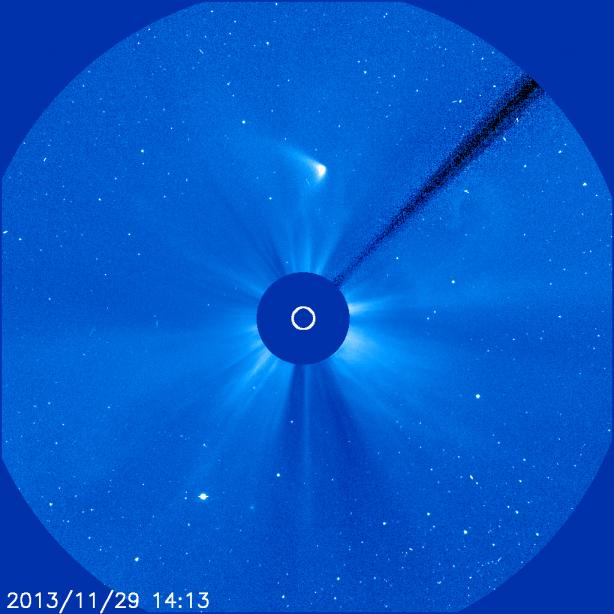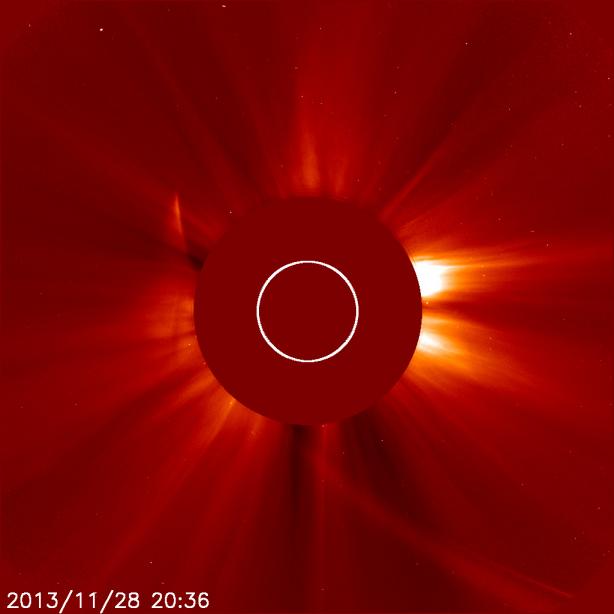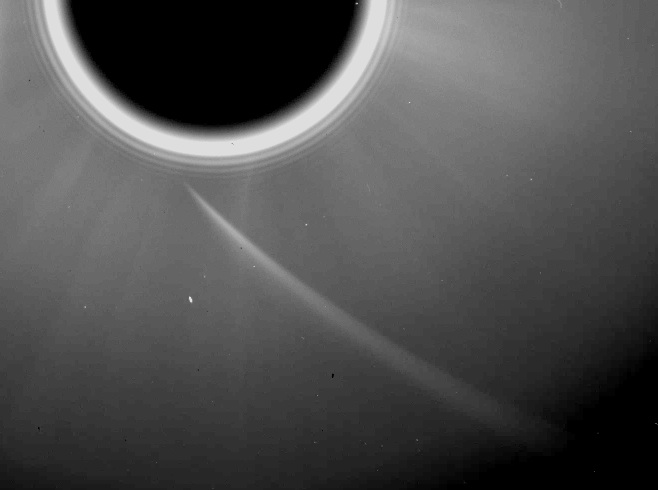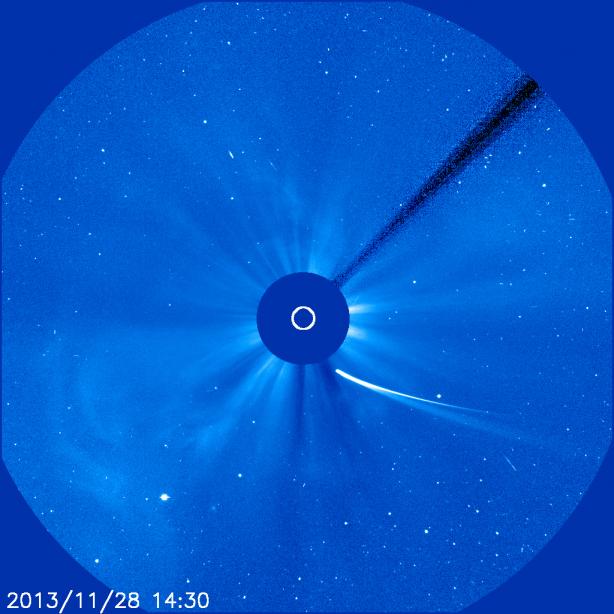THE COMETS OF 2014
2013-December-31
The following is an updated and expanded version of the ALPO Comet Section Report from the Winter 2014 JALPO (56-1).
Happy New Year!
2013 may not have produced its advertised comet of the century but it did produce 4 naked eye comets (though all were just marginally so). 2014 will also bring many comet observing opportunities with the discovery of additional new bright comets likely.
C/2013 R1 (Lovejoy) will start the year around 5-6th magnitude and still be visible in small telescopes (brighter than 10th magnitude) till March as it moves away from the Sun and Earth following its 0.81 AU perihelion on 2013 December 21. During January Lovejoy will slowly fade and can be found moving from Hercules to Ophiuchus.
A bit of a surprise (and an addition to the report published in JALPO) is Comet C/2012 X1 (LINEAR). Initially a faint comet, LINEAR was not expected to get brighter than ~12th magnitude near the time of its February 21st perihelion at 1.60 AU from the Sun. Surprisingly the comet was observed as bright as 8th magnitude in November 2013 after experiencing a major ~6 magnitude outburst. Though the outburst has subsided, the comet remains bright at around 9th magnitude at the end of December 2013. Forecasting the brightness of an outburst prone comet is always difficult but it is very possible that this comet will remain a nice small telescope comet through perihelion and beyond. The comet is a morning object and will remain so till the middle of the year. It is observable from the Northern Hemisphere until July and will become visible from the Southern Hemisphere starting in mid-February. In January, LINEAR starts the month around magnitude 8-9 to the southeast of the ‘head’ of Serpens Caput in the morning sky. As the month progresses the comet will move through northern Ophiuchus. By the end of January, comets LINEAR and Lovejoy will be located within 4° of each other.
In addition to Lovejoy, three more long-period comets are expected to become brighter than 7th magnitude in 2014. Comet C/2012 K1 (PANSTARRS) will reach perihelion on August 27 at a distance of 1.05 AU from the Sun. Starting the year at 13th magnitude, the comet will brighten to 7th magnitude in June and July before passing solar conjunction (unfortunately on the far side of the Sun). When the comet remerges from the glare of the Sun in September it will be a 6th magnitude object only observable from the Southern Hemisphere. PANSTARRS should still be around 9th magnitude by the end of the year.
Our next comet was discovered by Michael Ory at the Oukaimeden Observatory in Morocco at 18th magnitude. Comet C/2013 V5 (Oukaimeden) will reach perihelion on October 2 at a distance of 0.66 AU from the Sun. It is too early to be sure, but the comet should be brighter than 10th magnitude by August and as bright as 5-6th magnitude in late September when it passes within 0.46 AU of Earth. Northern Hemisphere observers will loss sight of the comet in mid-September though Southern observers will still be able to follow it into October.
Back in early October, Comet ISON made the news as it came close enough to Mars to allow NASA’s Mars orbiting spacecraft to image it. Comet C/2013 A1 (Siding Spring) will pass even closer to Mars on October 19, 2014. Definitely expect to hear more about this comet as it passes within ~150,000 km of Mars resulting in some high-resolution imaging from Mars. For us on Earth the comet should be a 7th magnitude object around its October 2 perihelion (r = 1.40 AU from the Sun). Again Southern observers will see this comet at its best as it will only become observable for Northern observers in November.
The next four comets may not become brighter than 10th magnitude but are worth mentioning. Short-period comet 209P/LINEAR will pass within 0.06 AU of Earth in late May at ~10-11th magnitude (r = 0.97 AU). Dust released by LINEAR during past orbits may result in a significant meteor shower on the night of May 24, 2014. The close approach will also allow imaging by radar telescopes giving us a resolved look at its nucleus. 15P/Finlay is another short-period comet which may be approaching 10th magnitude at the end of the year as it passes perihelion on December 27 (r = 0.98 AU). 2014 will bring not only resolved images of the nuclei of comets C/2013 A1 (Siding Spring) and 209P/LINEAR, but extremely high-resolution images of the nucleus of short-period comet 67P/Churyumov-Gerasimenko. This year the ESA Rosetta spacecraft will rendezvous with 67P and begin a multi-year campaign to study the comet at close-range. In 2014, 67P will still be around 3 AU from the Sun and around 18th magnitude.
The final comet is currently not a comet at all. Asteroid 2013 UQ4 was discovered by the Catalina Sky Survey on a very comet-like orbit with a period of hundreds of years. There is a good chance this asteroid is a comet that has either not turned on yet or its cometary activity is too weak to be detected. With its closest approach to the Sun on July 5 (1.08 AU) and to the Earth on July 10/11 (0.31 AU), 2013 UQ4 will be magnitude 12.9 if it remains inactive and possibly many magnitudes brighter if active.
Looking into 2015 and beyond there are two comets that could become nice small telescope objects near perihelion but will be faint in 2014. Monitoring their development in 2014 is essential for predicting their future performance. C/2013 US10 (Catalina) doesn’t reach perihelion until 2015 November 15 when it will be 0.82 AU from the Sun. The comet will also come within 0.73 AU of Earth in January of 2016 when it will be somewhere between 6th and 9th magnitude. As of the end of 2013, the comet is 7.8 AU from the Sun and 17th magnitude. Our other long-range comet is C/2013 X1 (PANSTARRS) which is currently even further out than US10 at 8.7 AU. Though now only 19th magnitude, it should substantially brighten when it reaches perihelion (1.30 AU on 2016 April 19) and closest to Earth (0.64 AU in late June 2016).
As always, the ALPO Comet Section thanks those who have sent observations during 2013 and solicit new images, drawings and magnitude estimates during the coming year. The Comet Section Image Gallery now contains 267 images of 56 comets including many of those mentioned above.









